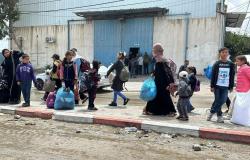UPDATE at 11:05. A team of investigators from the General Prosecutor’s Office went, on Friday morning, to Ion Iliescu’s residence, to inform the former president that he was again charged with crimes against humanity, in the June 1990 Mineriada file.
The team was formed by the prosecutor in charge of the Mineriada case, a policeman and another woman. They stayed only ten minutes in the villa where Iliescu lives.
In the case of Ion Iliescu, a special indictment procedure was applied, because he cannot go to the Prosecutor’s office, being 94 years old.
“In the case generically known as Mineriada from June 13-15, 1990, the military prosecutors within the Military Prosecutors’ Section ordered, on 19.04.2024, the continuation of the criminal investigation against Iliescu Ion, on the date of the facts, President of the Provisional Council of National Union and President-elect of Romania, under the aspect of committing crimes against humanity, in the normative variants prev. of art. 439 para. 1 lit. a) (4 secondary passive subjects), lit. f) (at least 2 secondary passive subjects), letter g) (at least 1315 secondary passive subjects), letter j) (at least 1214 secondary passive subjects) Criminal Code, with application. Art. 5 of the Criminal Code”, the General Prosecutor’s Office announced in a press release on Friday.
Charged with crimes against humanity
The former director of the SRI, Virgil Măgureanu, Adrian Sârbu, Miron Cozma, General(r) Vasile Dobrinoiu (former commander of the Superior Military School of Officers of the Ministry of the Interior) and General(r) Peter Petre ( former commander of Military Unit 0575 Măgurele). They were called to the Prosecutor’s Office on Thursday, to be informed of the accusations.
In June 2017, the former president Ion Iliescu and the other defendants were sent to court for crimes against humanity, but in December 2020, the High Court of Cassation and Justice decided to return the file to the Military Prosecutor’s Office, to redo the investigation from scratch.
The military prosecutors claim that, in June 1990, people with decision-making positions in the Romanian state at that time, including Petre Roman, Gelu-Voican Voiculescu, helped by other people close to power or who supported it – including Virgil Măgureanu – the director of the SRI , Adrian Sârbu – adviser to the prime minister, launched a policy of repression against the civilian population of the Capital.
As a result of their actions, four people were killed, two people were raped, the physical and/or mental integrity of over 1,300 people was harmed, and over 1,200 people were persecuted through illegal deprivation of liberty.
How the 1990 “Minerade” unfolded
Starting on April 22, 1990, a demonstration took place in Bucharest’s University Square that lasted for several weeks, until June 13, 1990.
The demonstration had the character of an opposition to the newly established power in Romania after the Revolution of 1989, the demonstrators requesting verbally, through communiques and other forms of protest, the break with the communist regime that had just been replaced in December 1989, the promotion of people who did not have an activist past of party, the establishment of a free television and other such demands of democratic origin.
In this context, Petre Roman, Gelu-Voican Voiculescu, Virgil Măgureanu and other people from the leadership of the state or the National Salvation Front launched an attack against the demonstrators physically located in University Square.
The attack was, in fact, a pretext intended to mask the repressive action against the people who previously participated in these demonstrations, especially the opinion leaders, as well as against any people who demonstrated or were likely to demonstrate a form of opposition, especially students , intellectuals or people who expressed closeness to Western values.
“To conceal the attack, a scenario was built with the aim of losing track of the real attackers. An important component of this scenario was the public, manipulative communication regarding the danger that the demonstrators represented for democratic values. Considering the scale of the attack, its implementation required the involvement of a very large number of people. In this sense, people from the state leadership – Petre Roman, Gelu-Voican Voiculescu, as well as the leadership of the SRI, respectively Virgil Măgureanu, with the participation of Adrian Sârbu, advisor to the prime minister, would have constituted, according to the administered evidence, a criminal group of systemic type, heterogeneous, of a political, administrative, military and civil nature, within which a large number of people were involved, with a contribution of different nature and content to facts produced on an impressive scale. In the criminal picture, the persons who physically carried out the acts of a criminal nature occupied a lower position in the hierarchy of the group, but the conception and orchestration of the commission of the crimes belonged to the political leadership of the Romanian state from that moment on, through the mentioned persons”, the prosecutors explain.
From the documents administered by the prosecutors, the “connivance” resulted in the planning and orchestration of the criminal plan, Petre Roman, Gelu-Voican Voiculescu and Virgil Măgureanu, together with other people with decision-making power, playing the key roles, but the way they chose to implement it was through other people, not participating in the agreement.
Repressive action against the demonstrators in University Square
The investigators show that, starting on June 13, 1990, the decision-makers from that moment put into practice a repressive action against the demonstrators in Bucharest’s University Square. In this attack, forces of the Ministry of the Interior, the Ministry of National Defense, the SRI, as well as over ten thousand miners and other workers from several areas of the country were illegally involved.
The repressive action had the character of a generalized and systematic attack, during which the following acts were committed: the shooting death of four people; the rape of two people; harming the physical or mental integrity of a total number of 1,315 people; the persecution through the illegal deprivation of the fundamental right to freedom and security and the restriction of this right, for political reasons, of a total number of 1,214 people.
Thus, in the morning of June 13, 1990, more than two hundred people were picked up and transported to the Military Unit 0575 Magurele of the Ministry of the Interior, where they were detained until the afternoon of the same day, when they were allowed to leave, after a brief survey.
At the same time, the buildings of the Institute of Architecture and the University of Bucharest were entered by force, without right, and several offices were searched, and the people in the premises were evicted through acts of violence.
According to the decision taken by the political factors, leaders of the law enforcement agencies, as well as by people from the leadership of the National Salvation Front, workers from the Bucharest Heavy Machinery Company were brought to University Square, who demonstrated violently, physically assaulting people located in the area of the Architecture Institute, after which they occupied the University Square, together with the police, to prevent the return of the demonstrators.
The actions taken by the state authorities generated a violent response from the opponents, so that the headquarters of the Capital Police, the Ministry of the Interior, the Romanian Television and the Romanian Intelligence Service were set on fire.
The authorities used live ammunition
A weapon with war ammunition was used by the law enforcement forces, in these circumstances four people were fatally shot.
The repression of the authorities continued on June 14 and 15, 1990, through a systematic attack carried out together with miners and workers from several counties of the country, who had become a real law enforcement force, parallel to those recognized and organized according to the law.
In this context, the miners brought to Bucharest devastated the headquarters of the political parties newly established or re-established after the Revolution of December 1989 and which were in the opposition, the residences of the main political leaders of the opposition and the headquarters of independent press publications and some educational institutions. They also assaulted residents of Bucharest, under the pretext that they are related to the demonstrations in University Square.
The persons who were picked up from the University Square, together with others considered to be related to the demonstrations, were taken by force to the Military Unit 0575 Măgurele and to the premises of the Superior Military School of Officers from Baneasa, being illegally deprived of their liberty and in spaces totally unsuitable for holding some people. Their deprivation of liberty without legal forms lasted until June 21, 1990 at the latest.
The accommodation of the civilians brought from the streets of Bucharest was carried out in completely inappropriate conditions, in garages, both men and women, minors and the elderly. These people were permanently under military guard, not being allowed to contact their relatives or anyone else from outside, without receiving adequate medical assistance and being subjected to humiliating and degrading treatments (including by simulating collective executions or by collective gassing by releasing exhaust gases in holding spaces).
The prosecutor’s office specifies that the state of facts retained and the legal classification of the facts are based exclusively on the evidence administered after 04.06.2021, the date on which the case was returned to the prosecutor’s office, as a result of the preliminary chamber procedure, as a result of which they were all tests administered before 2017 were canceled and the nullity of the previously performed follow-up documents was found.
Follow us on Google News
Tags: Ion Iliescu Indicted Mining File Prosecutors Visited Home
-





